
Happy 34th Anniversary + 19 days to my wonderful wife(who says that you can't celebrate it every day! Or keep celebrating the Integral Heart Family's record breaking fund raising last month for their wonderful children: https://www.marketforum.com/forum/topic/34791/
Scroll down and enjoy the latest comprehensive weather to the max...... occurring because of the natural physical laws in our atmosphere.
Watching Dorian in the Southeast. Cotton market is nervous after being annihilated in GA by Michael last year. Will Dorian get very far west into the Gulf???
As expected, crop ratings increased on Monday from rains last week....... +1% corn, +2% beans. The increase in beneficial CO2 continues to result in crops doing much better than expected too.
No sustained heat. Overall still bearish grains(though mostly dry in many places this week) with the rains this week in the southwest belt.
We are watching for the potential of a frost threat now but on Thursday, it's not a big threat.
For natural gas: Expiration of the front month dominated on Wednesday.
Temperatures continue to be moderating closer to average in the Midwest in week 2, with enough heat to generate significant cooling demand in some places..............looking warmer today late week 2!
Here are the latest hazards across the country.
Purple/Pink/blue on land is cold/Winter weather. Brown is wind, Green is flooding. Gray is fog. Reddish is a red flag advisory.
Go to the link below, then hit the location/county on the map for details.
https://www.spc.noaa.gov/ Go to "hazards"

Current Weather Map
| NCEP Days 0-7 Forecast Loop | NCEP Short-Range Model Discussion | NCEP Day 3-7 Discussion |



Wind map Press down on this on the left with your cursor!


Current Jet Stream

| Low Temperatures Tomorrow Morning |

Highs today and tomorrow.
Warming up today Midwest ahead of the next cold front!!
Heat in the Southwest to West Coast.



Highs for days 3-7:
Warmer!
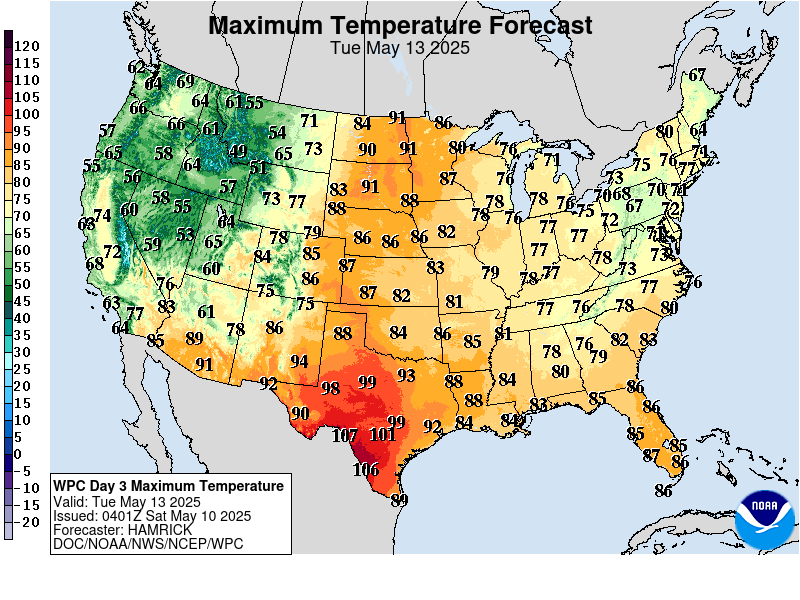
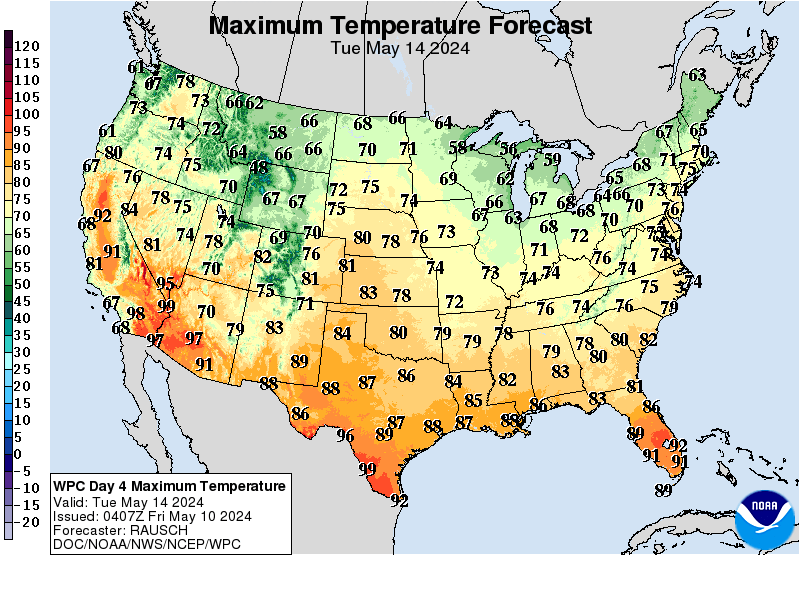
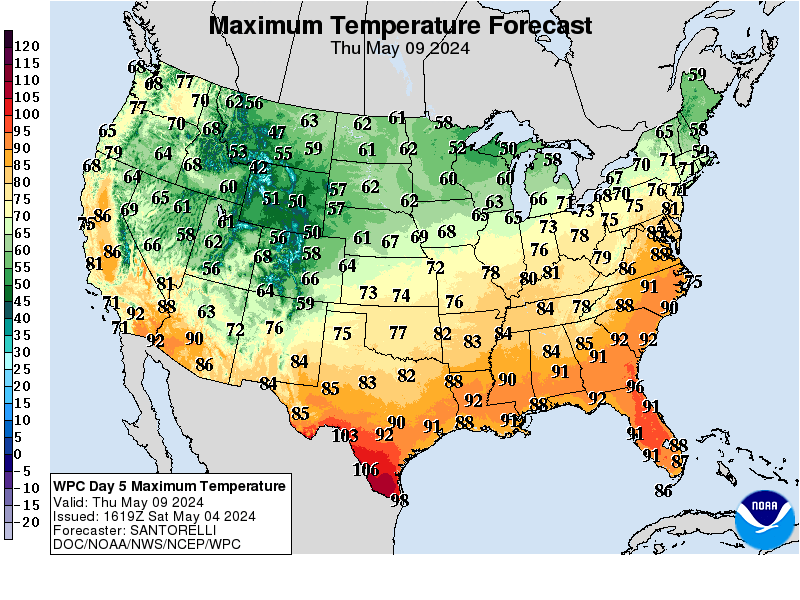
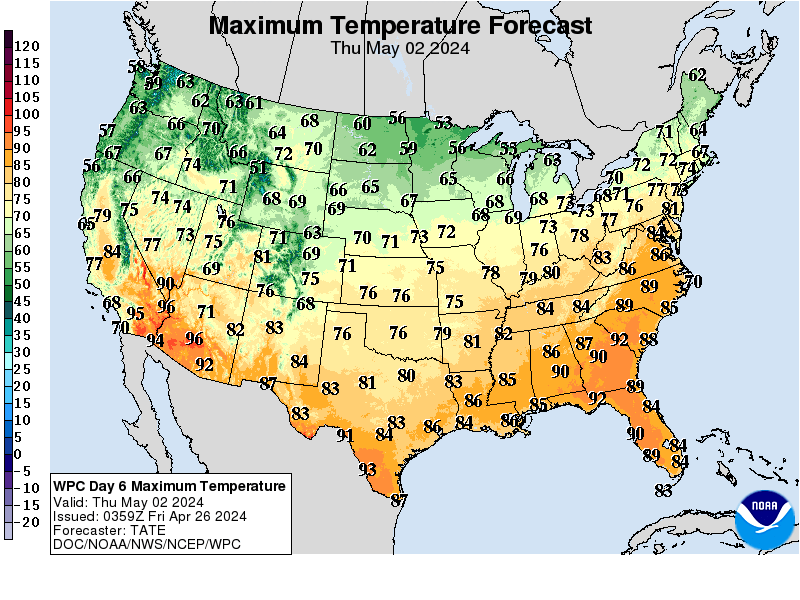
We have passed the peak in Summer temperatures based on climatological/historical averages by OVER a month now.
The heat during this period will start in the West. At,or warming to above average most other places.
https://www.wpc.ncep.noaa.gov/medr/medr_mean.shtml
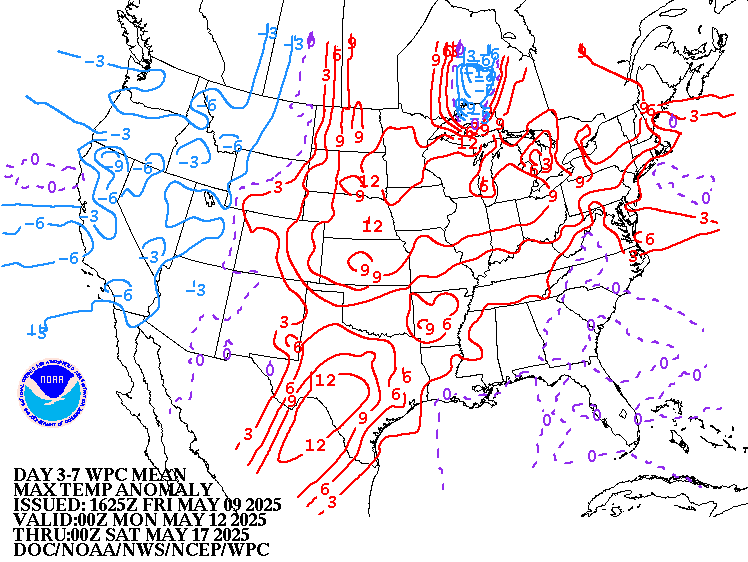
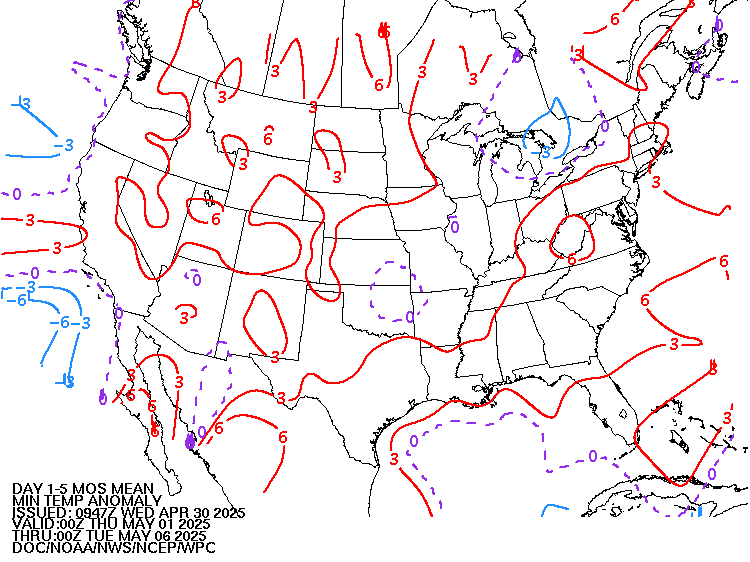
Weather maps for days 3-7 below
Watching to see where Dorian goes in the Southeast!
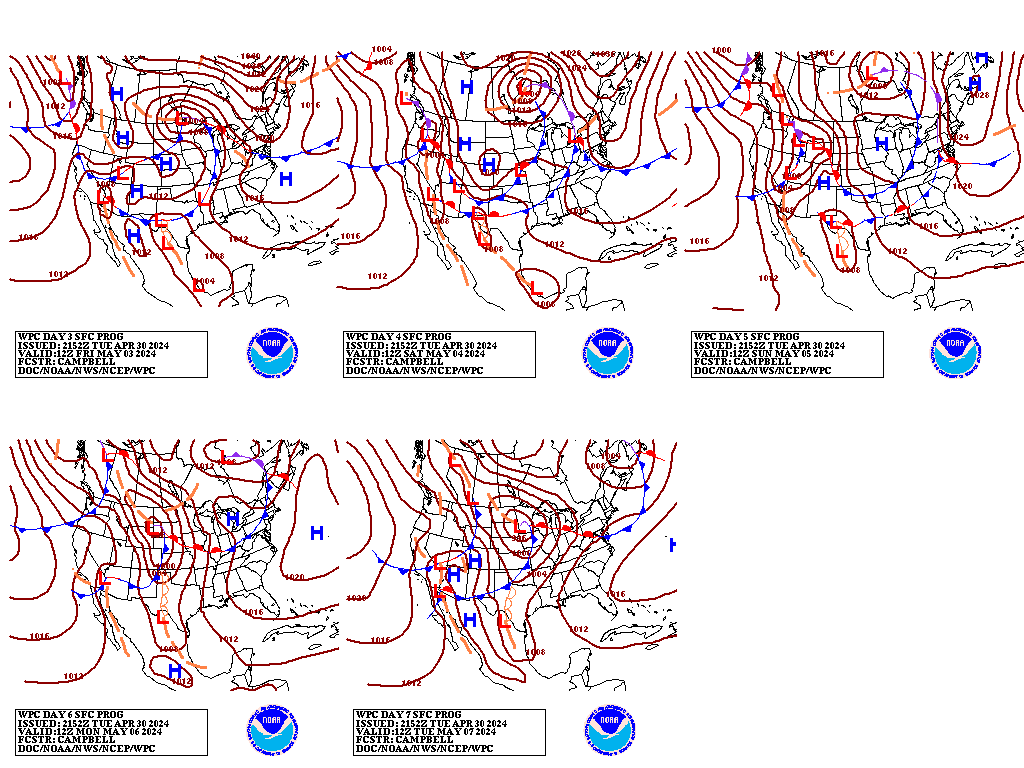
Liquid equivalent precip forecasts for the next 7 days are below.
Not as wet,except the Southwest Cornbelt.
How much of the heavy rains from Dorian will dump on the Southeast(how far inland)? Important to cotton concerns.
Day 1 below:
http://www.wpc.ncep.noaa.gov/qpf/fill_94qwbg.gif?1526306199054
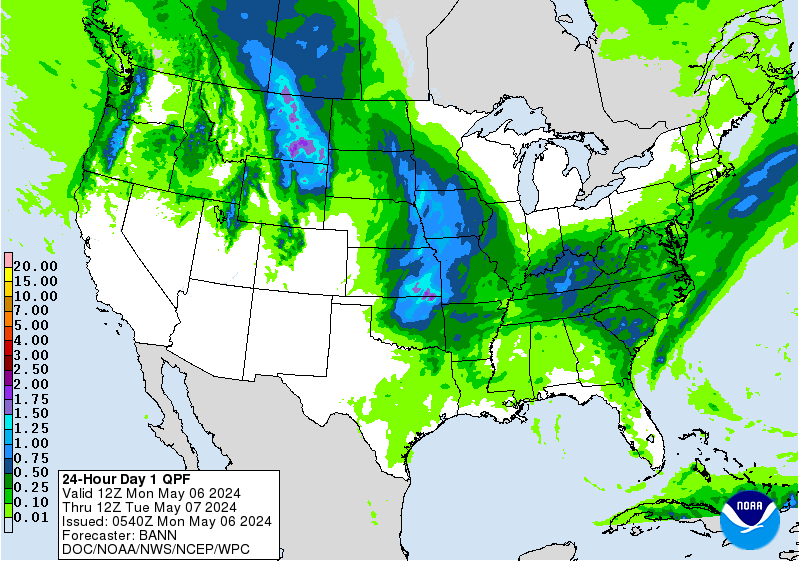
Day 2 below:
http://www.wpc.ncep.noaa.gov/qpf/fill_98qwbg.gif?1528293750112
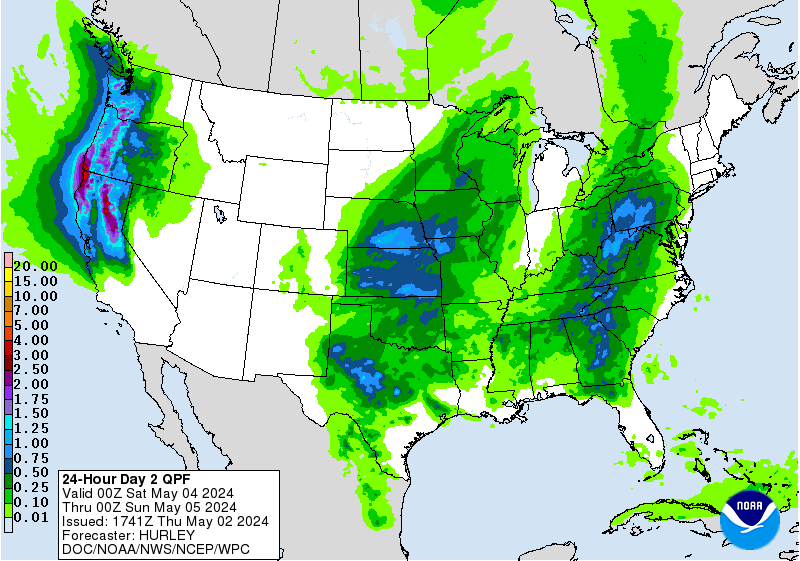
Day 3 below
http://www.wpc.ncep.noaa.gov/qpf/fill_99qwbg.gif?1528293842764
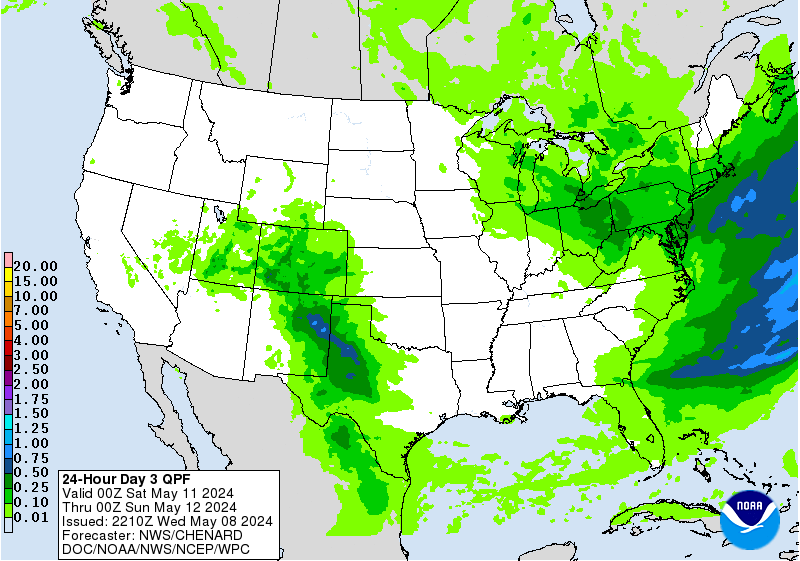
Days 4-5 below:
http://www.wpc.ncep.noaa.gov/qpf/95ep48iwbg_fill.gif?1526306162
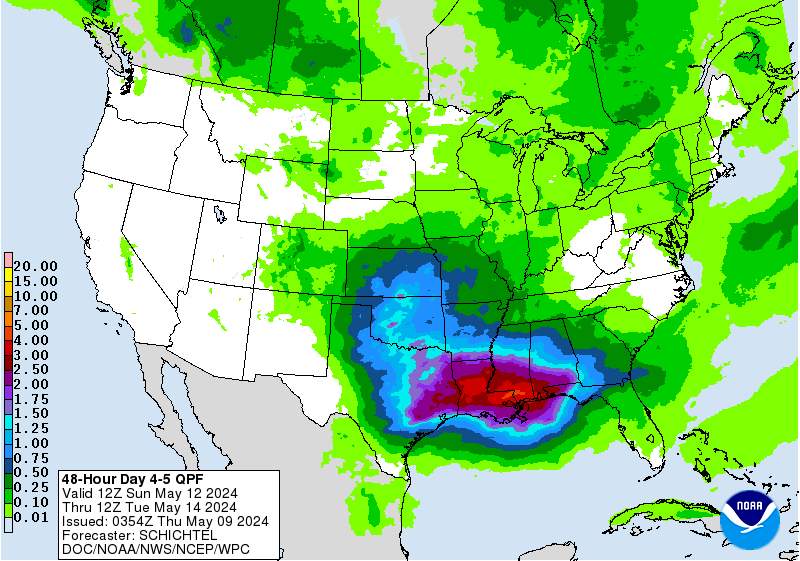
Days 6-7 below:
http://www.wpc.ncep.noaa.gov/qpf/97ep48iwbg_fill.gif?1526306162
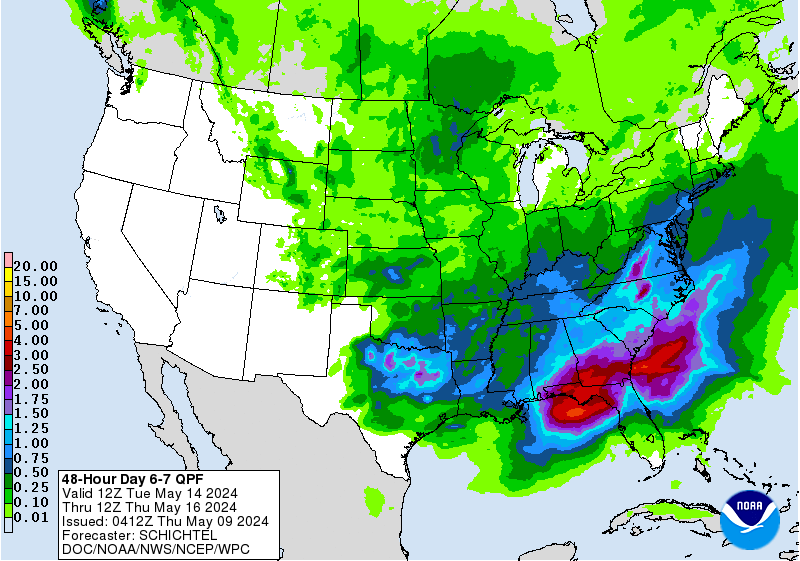
7 Day Total precipitation below:
https://www.wpc.ncep.noaa.gov/qpf/p168i.gif?1566925971
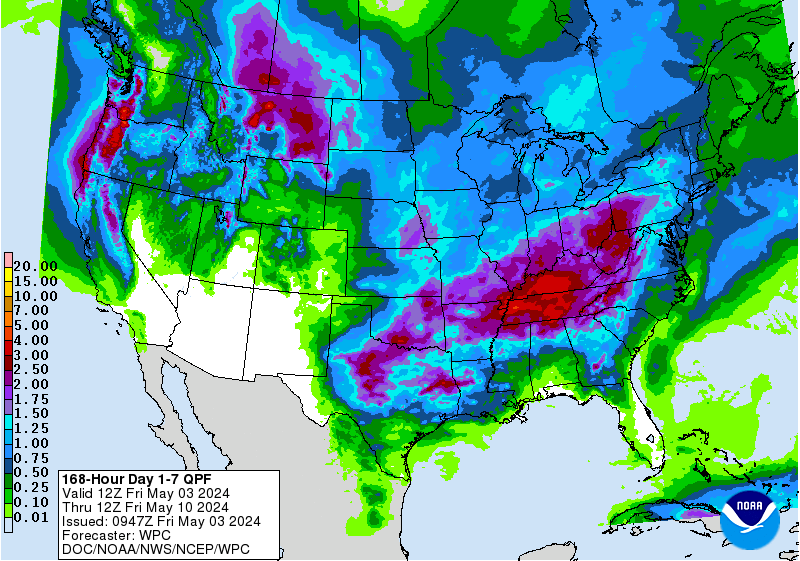
| Risk of excessive rains. Mesoscale Precipitation Discussions
Day 1 Threat Area in Text Format
Day 2 Threat Area in Text Format
Slight risk with the cold front dropping south early this week. https://www.spc.noaa.gov/
|
Last 24 hour precip top map
Last 7 day precip below that
https://www.wunderground.com/maps/precipitation/daily


Current Dew Points
Dry air, refreshingly pleasant air has pushed well south of the Ohio River.

Latest radar loop
http://www.nws.noaa.gov/radar_tab.php


| (3400x1700 pixels - 2.2mb) Go to: Most Recent Image |

Go to: Most Recent Image
You can go to this link to see precipitation totals from recent time periods:
https://water.weather.gov/precip/
Go to precipitation, then scroll down to pick a time frame. Hit states to get the borders to see locations better. Under products, you can hit "observed" or "Percent of normal"
+++++++++++++++++++++++++++++++++++++++++++++++
Precipitation compared to average for the last 7, 14, 30 and 60 days.
Some spots in Iowa and especially N/C Illinois have dried out!
Usually not updated for previous day until late the next day.
https://www.atmos.illinois.edu/~snodgrss/Ag_Wx.html




Soilmoisture anomaly:
These maps sometimes take a day to catch up to incorporate the latest data(the bottom map is only updated once a week).
A big chunk of the central and eastern Cornbelt finally got some rains..........in most spots last week. Corn and bean crop ratings improved.
https://www.cpc.ncep.noaa.gov/products/Soilmst_Monitoring/US/Soilmst/Soilmst.shtml#
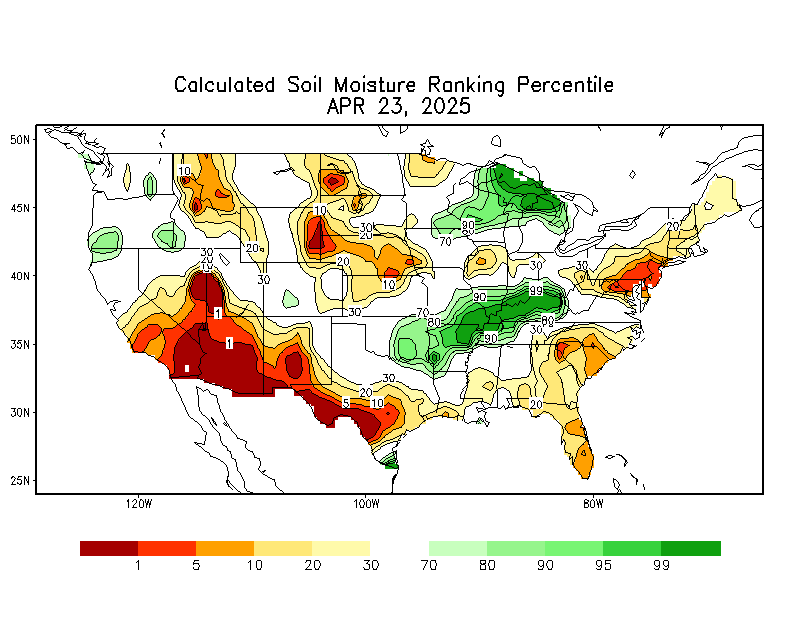
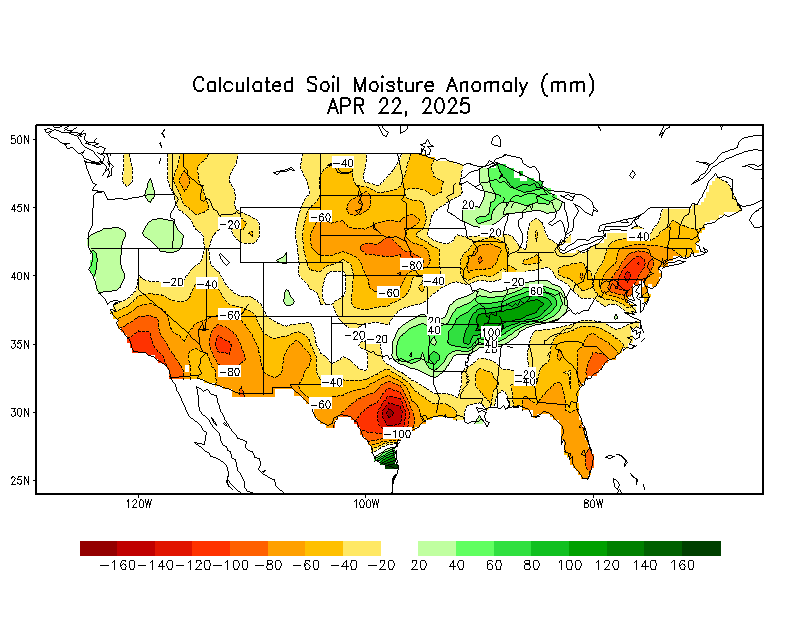
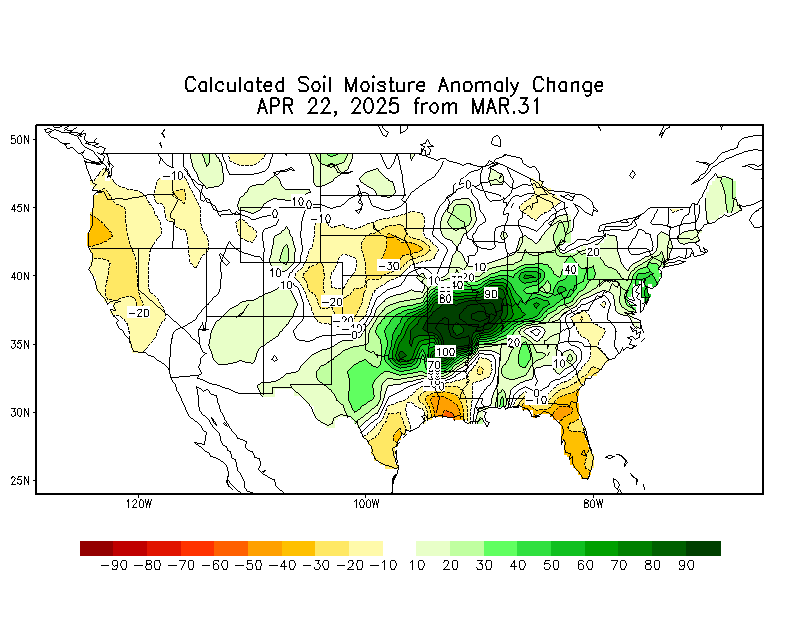
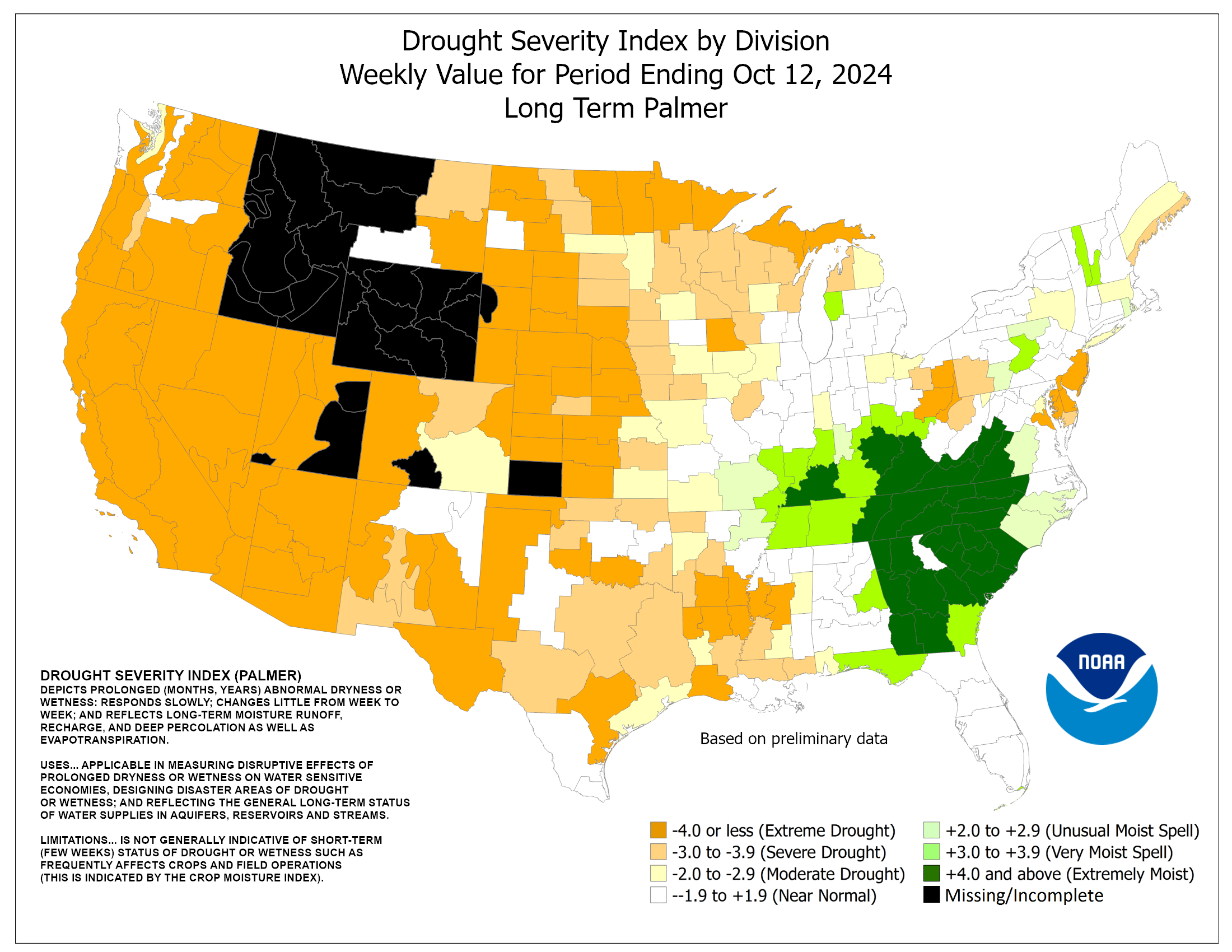
Latest: The first map below is the latest. The 2nd one is from last week.
In july/August, it's typical to see some increase in drought because of heat being a factor in evaporation, seasonally exceeding low rainfall during this month.
The amount of drought on THIS week's update barely shrank in the Midwest but it got worse for TX cotton.
The map below is updated on Thursdays.
https://droughtmonitor.unl.edu/


| 05 | 0.00 | 35 | |||||
| Change | 1.44 | -1.44 | -1.79 | -0.20 | -0.12 | 0.00 | -4 |
The top map is the Canadian ensemble average, the maps below are the individual members that make up the average at the end of week 2.
+++++++++++++++++++++++++++++++++++++++++
Each member is like the parent, Canadian model operational model.......with a slight tweek/variation in parameters. Since we know the equations to represent the physics of the atmosphere in the models are not perfect, its useful to vary some of the equations that are uncertain(can make a difference) to see if it effects the outcome and how.
The average of all these variations(ensembles) often yields a better tool for forecasting. It's always more consistent. The individual operational model, like each individual ensemble member can vary greatly from run to run.........and represent an extreme end of the spectrum at times. The ensemble average of all the members, because it averages the extremes.............from opposite ends of the spectrum.........changes much less from run to run.
End of week 2....................0z ensembles:
Analysis starting from a week ago, ending with today:
Last week+ of analysis, starting with the day farthest in the past. This is an end of week 2 forecast!
Last Thursday: Huge disparity in location of where the strong jet stream will buckle(that carves out a deep trough which extends from much of Canada, into the US)!!! The solutions that do it farther west pump up a heat ridge in the East. Those that do it farther east, have the opposite.........an upper level trough in the East. The Canadian model has more ridging in the east (and south) than some the other models also vs its solution yesterday.
Friday: 12z run. Interesting to note the heat ridge on so many members in the Southcentral to Southeast US. Some wild solutions in Canada with a full latitude, major league upper level low/trough that extends south into the US. A much more pronounced northern stream could evolve out of this feature if the upper level ridging in far Western North America allows for more amplification downstream. That would be the first indicator for a legit major freeze threat with the right positions of those features..............but there can be no freeze without a ridge west/trough digging south downstream configuration/couplet.
Saturday: Big change again in the heat ridge. Much more suppressed today with a trough in the Midwest to just eastward. But thats just the ensemble average. The individual solutions show massive disparity. A minority have a huge heat ridge in the east. All depends on where the deep upper level trough in Canada extends south into the US at.
Sunday: Location of upper level trough?? For sure in Canada with a strong jet stream underneath. Heat ridge to its south and east in the US......probably.
Monday: Heat ridge in the Southeast is stronger today.......carried on a couple more solutions and a slight majority.
Tuesday: On this model, the heat ridge in the Southeast is more impressive again today. Trough in the west. This couplet, if amplified more could lead to some heavy rains between the 2 features with a decent jet stream................at a time of year that is often pretty dry.
Wednesday: Less ridging in the south on this model today. More zonal flow northern tier.
Thursday: A tad more ridging in the Southeast. No frost threat.
360h GZ 500 forecast valid on Sep 13, 2019 00 UTC
0Z GFS Ensembles at 2 weeks:
Analysis, starting with the oldest, ending with the most recent:
Last Thursday: Where will the deep trough in Canada and associated strong jet stream into at least the northern tier of the US be? Potential heat ridge farther south of this feature if it would stay west or track zonally along the US border. Solutions here strongly favor a buckling of the jet deeply into the central of the country.
Friday: How deeply into the US will the big trough in Canada penetrate? Where will this be at? Northcentral US looks likes the most likely.
Saturday: Preferred position for the big upper level trough today is around the Hudson Bay in Canada, extending pretty far south across the US border.
Sunday: Not clear. Upper level trough in Canada, strong jet underneath, potential heat ridge somewhere in the US.
Monday: Upper level ridging, maybe in the Southeast. No longer the pronounced troughing in the N/C US. Not as cool as last weeks maps.
Tuesday: This model has a bit more northern stream potential than the Canadian model.......at least on this particular run. That's what's needed to have frost potential.
Wednesday: More zonal look to jet stream along the northern tier vs an amplied pattern that would be needed to pull down much colder air(which is absent in the US today)
Thursday: Ridge in the south could expand. Upper level trough/low Pacific Northwest is agreed on by most models...........favors downstream ridge amplification if the northern stream doesn't interfere which looks to be the case.

GFS Ensemble mean(average of all the individual solutions above). The first map is a mid/upper level map. The 2nd one is a temperatures map at around 1 mile above the surface. These are anomalies(difference compared to average). The daily analysis starts with the oldest and ends with the latest.
Last Saturday: Center for the positive anomaly is now in SW Canada to just off the coast to the Gulf of Alaska with a downstream negative anomaly centered in the Great Lakes. This is usually a pretty good couplet for cool temperatures in the Midwest.
Sunday: Weaker positive anomaly off the West Coast of North America, weak negative anomaly around the Midwest. Not a strong signal for heat but neither is it especially cool.
Monday: The only significant anomaly is a positive one off the Pac NW Coast. Otherwise, near average and nothing strong to key off of. Probably a strong jet stream along the northern tier.
Tuesday: Positive anomaly again is off the Pac NW Coast. Slightly below average heights and cyclonic flow in the center of the country........so wet and cool.
Wednesday: Same as Tuesday. Positive anomaly off Pac NW Coast, modest positives along the East Coast, negative with trough in the middle of the country where is would be wet and cool.
Thursday: Similar to Wednesday. Positive anomaly off the Pac NW Coast. Negative anomaly from Hudson Bay, extended to a weakness in the Midwest. Slight positive in the Southeast, possible ridging ahead of the deep trough.
Friday: Still the modest positive anomaly off the Pac Northwest Coast. Upper trough to the east has so many variations, that it doesn't show up with that big of a negative departure in 500 mb heights average in any one place.
Saturday: Modest positive anomaly but growing/extensive all the way north across North America........modest negative anomaly downstream from north of the Hudson Bay, southward. If these anomalies increase in magnitude, they would make for a nice couplet to deliver northern stream driven cold waves southward after the first week in September.
Sunday: Yesterdays couplet is gone. Slight negative anomaly sw Canada. Modest positive anomalies US, downstream so probably warming up in the middle of the country.
Monday: Similar to Sunday. No strong anomaly disparities to key off of. Maybe just zonal flow across the US, especially northern half and not as cool in the Midwest as recent week 2 maps.
Tuesday: Negative anomaly now just off the US West Coast. Could be associated with an active jet stream aimed at parts of the Midwest? Modest positive anomalies downstream. Another positive anomaly in Alaska is going to have to get some/better cooperation downstream to connect strongly enough in order to deliver a blast of chilly air thats cold enough for frost in the Upper Midwest. There is a slight weakness in E.Canada that has potential.
Wednesday: Anomalies are pretty close to average everywhere. So, flat zonal flow in the north and no extremes with ridging favored far south and an upper level trough in Canada which is typical in September.
Thursday: Negative anomaly Pacific Northwest stands out/is agreed upon. Modest positive anomalies downstream, some ridging in the south likely.
NCEP Ensemble t = 360 hour forecast
Latest, updated graph/forecast for AO and NAO here, including an explanation of how to interpret them...............mainly where they stand at the end of 2 weeks.
Previous analysis, with the latest day at the bottom for late week 2 period.
Last Thursday: Changes. AO still near 0. Now we have a huge disparity/spread in the NAO at the end of 2 weeks because the pattern is very sensitive to where the trough/ridge couplet sets up from Canada to the US and points eastward and there is great disagreement on this. PNA increases, which favors the trough east and cool weather.
Friday: Today, all the indices are near 0, so no big help.
Saturday: AO and NAO near 0. PNA a bit positive at the end of 2 weeks.
Sunday: AO near 0. NAO drops just below 0 very late. PNA gyrating above 0.
Monday: No strong signal or suggestion of anomalous type weather.
Tuesday: AO and NAO near 0. PNA has a wide spread as that indice is very sensitive to the pattern/positions of an upper level trough and ridge in Western North America.
Wednesday: AO drops to near 0. NAO near 0 and PNA drops from positive to near 0 at the end of 2 weeks. Nothing at all suggested out of the ordinary.
Thursday: AO drops from positive to near 0. NAO near 0 and PNA stays bit positive with a wide spread its sensitive to the upper level trough off the NW Coast's position relative to features surrounding it.
National Weather Service 6-10 day, 8-14 day outlooks.
My comments below are usually made hours before the afternoon update, starting with the oldest comment.
Last : Thursday: Should be pretty wet(rains dry up in the 8-14 day period) and very cool in the middle and again, temps chilly enough for some 30's at the end of week 1 and start of week 2 in the Plains to Upper Midwest. How much warmth along the East Coast. The West Coast looks very warm to hot.
Friday: We should be drying out in many places. Temps remaining cool in the middle(but not as cool as week 2 progresses) with some heat around the edges.
Saturday: Still cool in the center and drying out in some places.
Sunday: Still cool but NOT AS cool, in fact, closer to average Midwest by the end of week 2. 6-10 day is on the dry side but then more rains possible again.
Monday: Not as cool, closer to average Midwest? Fairly dry in the 6-10 day.
Tuesday: After turning drier early in the extended, it looks to turn wet. Temps? Not as cool in the middle as last weeks outlooks but there is uncertainty.
Wednesday: Dry start to the 6-10 day, then turning wetter again, especially 8-14 day. No temp extremes but not as cool in the middle as recent outlooks.
Thursday: Turning wetter again. More warmth than cool, especially south.
Temperature Probability
| the 8-14 day outlooks ArchivesAnalogsLines-Only FormatGIS Data | |
Temperature Probability | |
 | |